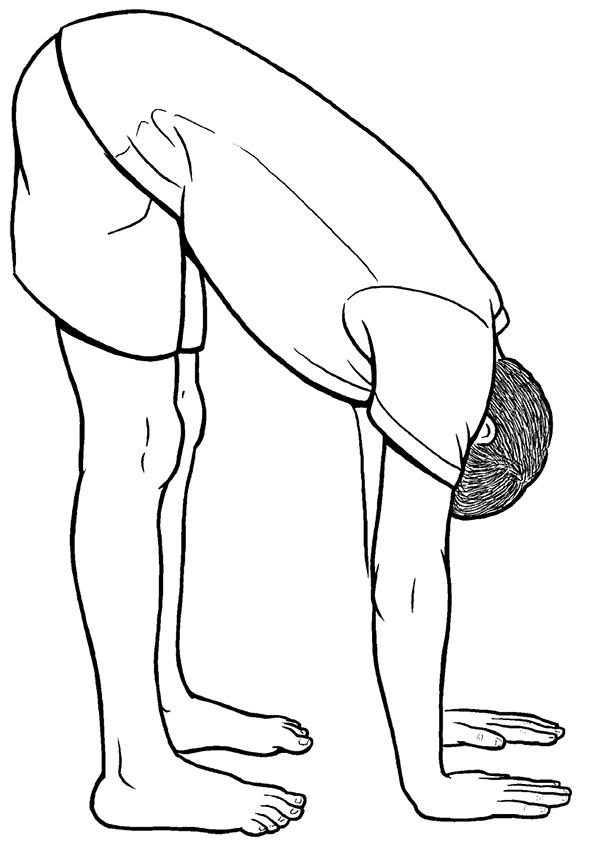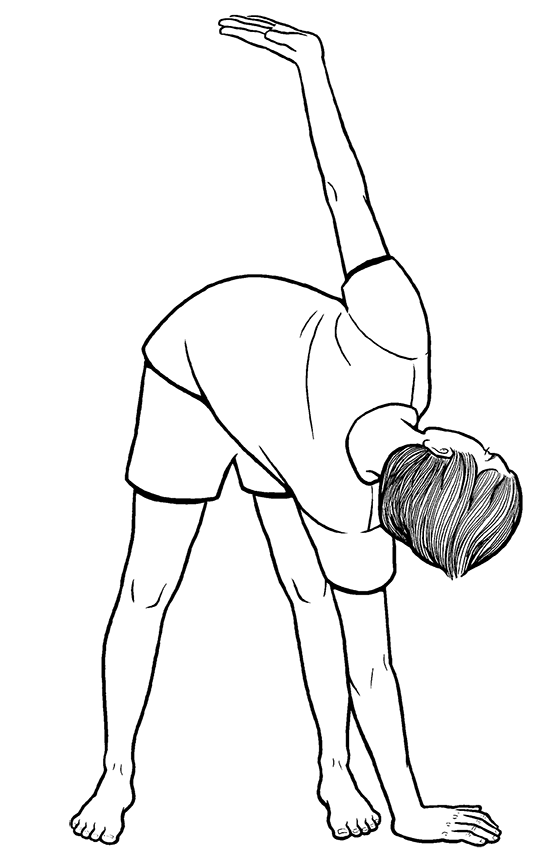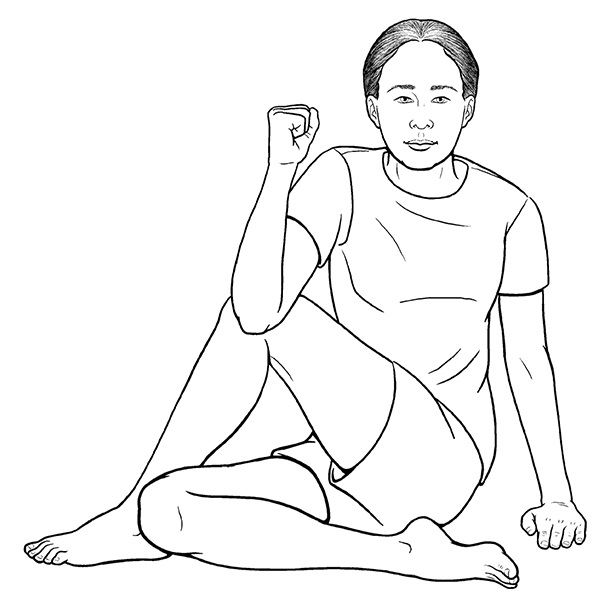Chinese Healing Exercises (20 page)
Read Chinese Healing Exercises Online
Authors: Steven Cardoza
Tags: #Taiji, #Qi Gong, #Daoist yoga, #Chinese Healing, #Health, #medicine, #remedy, #energy

Purpose
Physical:
Stretches and opens the back muscles, and will additionally stretch the hamstring muscles if they are tight. Increases space at the rear of the vertebral column, improving the alignment of the vertebrae. This also reduces compression on the intervertebral discs, reducing disc wear, and allows them to rehydrate (absorb fluid) and “plump up,” so they can better cushion the vertebral bones. That reduces bone wear and may help to prevent arthritic changes in the back. Because of positional changes in the head, coupled with the stretch through the neck, blood flow into and out of the brain may be improved.
Energetic:
Opens the Urinary Bladder and Du meridians, removing obstruction to qi flow in those channels. Associated benefits are discussed in the introduction to this chapter.
Techniques used
Stretching, gravity-facilitated release, Daoist yoga, focused breathing.
 Figure 6.9 (Standing Toe Touch, Legs Together)
Figure 6.9 (Standing Toe Touch, Legs Together)
Method
Stand with your feet very close together. Ideally they should be touching along their entire length, but if your balance makes that too difficult, spread your feet apart only wide enough so that you feel secure and stable. Keep them parallel. Also keep your knees straight, but not locked, through the entire exercise. Inhale, and then on the exhalation bend forward, moving the tips of your fingers toward the tips of your toes. At some point before you're able to reach your toes, you may be unable to bend farther, coming to the end of your stretch. In that position, simply take a few more slow, deep breaths, direct your breath to the tight areas of your back, and on every exhalation release more of that tension as best as possible. You may find that you're able to get your fingers a little closer to your toes in that way. Do not try to forcibly stretch your arms to make your fingers extend to your toes. That will often put an undue strain on your back. Remember, the purpose here is not to touch your toesâthat's just a reference targetâbut to open your back.
If you can touch your toes, you may comfortably be able to place the palms of your hands flat on the ground (
Fig 6.9
). That's the next and final physical step to work toward in this exercise. Until that becomes comfortable, breathe as directed above to facilitate more release in your back. Some very flexible people may be able to grasp the back of their ankles and pull their forehead to their knees, common in yoga practices for example, but that's neither necessary nor desirable for this exercise.
At whatever point you come to the end of your stretch, let your neck relax, so that your head hangs loose, pointing toward the ground. Feel the weight of your head create a traction that further stretches your back, continuing through your entire neck. Again use your breath to release any tension you may feel, allowing your entire back to open more fully. Stay in this stretch for just two or three breaths at first, gradually building up to ten breaths over the course of a month or more.
On an inhalation, rise slowly to full upright position. It's possible you may feel dizzy, either while bent forward or more typically when rising. This is due to changes in bloodflow and pressure into and out of your head; it can be minimized by rising slowly. With continued practice over time, the dizziness will pass, one yardstick of improvement, but take it slowly and carefully until then.
7. Opposite Leg Toe Touch, the Whole Body Windmill
This exercise builds on and adds to the previous one, and so should only be attempted after you can at least touch your toes with the tips of your fingers. It is similar to but different from the common Windmill Toe Touch practiced in calisthenics.
Purpose
Physical:
Stretches and opens the back muscles, stretches the hamstring muscles, and increases space at the rear of the vertebral column, improving the alignment of the vertebrae. A rotational component is added to the stretch through the back and torso, legs, and neck. Although not specifically an exercise for the shoulders, the arms are used here in a way that moves the shoulders through a large portion of their range of motion, opening them and the armpits. Practiced more vigorously than the previous exercise, bloodflow is increased throughout the body. Because of positional changes in the head, coupled with the rotational stretch through the neck, bloodflow into and out of the brain may be improved.
Energetic:
Opens the Urinary Bladder and Du meridians, removing obstruction to qi flow in those channels. Because the rotation of the torso opens the sides of the body, the Gall Bladder meridian is stimulated. The internal organsâespecially the liver, gall bladder, stomach, and spleenâare massaged and are benefited physically and energetically.
Techniques used
Stretching, twisting (rotational stretch), focused breathing.
Method
Stand with your feet parallel and 2
1
â
2
to 3 feet apart in a comfortably wide stance, knees straight but not locked. Raise your arms straight out at your sides so that your hands are at about the height of your shoulders, fingers to the sky and palms facing outward as though you were standing in a narrow hallway and your palms were touching the walls to either side of you. Elbows should be straight but not locked, and ideally the tips of the elbows should be pointed down toward the ground
(
Fig 6.10A
).
That will help keep your shoulders and neck open.
Inhale fully, and on a slow exhale bend forward, keeping your spine straight as much as possible, while turning your torso to the left. Lower your right arm and extend your right hand to touch your left foot. If you are able to stretch farther, place the palm of your hand on the ground directly in front of your left foot, or to the left of your foot if you want even more stretch. Simultaneously raise your left arm, moving it above your head so that the palm is facing the sky and your fingertips are pointed to the right. Turn your head to the left, and look upward toward your left hand as your right hand touches your left foot
(
Fig 6.10B
).
Inhale as you rise to your starting position, upright and arms out to your sides, and then repeat, this time turning to the right.
 Figure 6.10A (Opposite Leg Toe Touch,
Figure 6.10A (Opposite Leg Toe Touch,
the Whole Body Windmill)
 Figure 6.10B (Opposite Leg Toe Touch,
Figure 6.10B (Opposite Leg Toe Touch,
the Whole Body Windmill)
If you want to increase the release in a tight body part, you can hold the position with your hand to the ground and head turned to your upper hand, and breathe into any tight area for a number of breaths before returning to an upright position. If you want more aerobic benefit, you can do the exercise more rapidly once you are comfortable with it.
8. Seated Torso Twist
This is a variation of a popular yoga posture, an example of how similar exercises may arise in different cultures, sometimes for the same or similar purposes, and sometimes for very different ones. This is another more challenging stretch, requiring your legs and hips to be already fairly open. Depending on how flexible you are currently, and as a reminder, you may elect to skip this exercise for now, until your body opens more from practicing other exercise. This is of course true for any exercise you may find too difficult. Don't let that discourage you from doing the ones you can, as they will help you on their own and make it possible for you to do more difficult ones farther down the road.
Purpose
Physical:
Creates a strong rotational stretch throughout the whole spine, increasing the benefits begun in other rotational spine stretches, and stretches the hip rotator muscles. Helps stabilize the pelvis and hips, opens the low back, promotes freer movement between the pelvis and low back, and reduces low back pain.
Energetic:
Opens the Urinary Bladder and Du meridians, removing obstruction to qi flow in those channels. Both the rotation of the torso and the hip rotator stretch opens the sides of the body, so the lower portion of the Gall Bladder meridian is opened and qi flow is stimulated. Opens and activates the Daimai (Girdling or Belt Vessels, which energetically bind and connect with all the regular acupuncture meridians), benefits the kidneys, and stimulates the Mingmen (Life Gate, or Gate of Vitality, an energy center located between the Kidneys.)
Techniques used
Stretching, rotational stretch/twist, Daoist yoga, focused breathing.
Method
Sit on the floor. Fold your right leg beneath you by bending your right knee, keeping your knee on the ground, and slide your right foot beneath your left upper thigh, so that your right heel is at or just under your left buttock. With your left leg bent at the knee, place your left foot flat on the floor just to the right of your right knee. In this position, your left leg is crossed over your right. Keep your lower left leg from knee to ankle as close to vertical as possible, that is, not leaning to one side or the other. Place your left palm flat on the floor for support, just to the left of, or as far to the rear of your left hip as is comfortable. Alternatively, you may prefer to make a fist instead of using a flat palm, as that will give your left side slightly more lift and aid in keeping your spine perpendicular to the
ground. Turn your body a little to the left, and place your right elbow just to the left of your
left knee, in solid contact with it. Make a soft fist with your right hand, and move your right forearm perpendicular to the ground, so that your fist is directed toward the sky. For many people, this is already a significant stretch.
If you're able, keeping your right forearm perpendicular, move it to the right, pushing your left knee farther to the right. Simultaneously push your left hand into the ground and forward, so that it moves your torso rearward to the left
(
Fig 6.11
).
This will twist your whole spine, and your lumbar (low back) spine in particular. It's common to feel and hear a cracking and popping when doing this, much like a chiropractic adjustment. Do your best to keep your spine upright, perpendicular to the ground.
When you reach the limit of your stretch, incorporate your breath in order to gradually increase the stretch. Inhale slowly and fully into the areas you feel are most tight, and on an equally slow and full exhale, release the tension in those places and see if you can increase the stretch just a little more, turning your body slightly more to the left. Repeat until you are unable to increase the stretch, being careful to avoid causing yourself pain. Hold this stretch for just four or five breaths to start, breathing into any areas of tension or discomfort, and release that tension with each exhalation. Over time, you can increase that to ten or more if you like. Then repeat the above in the opposite direction, facing right.
 Figure 6.11 (Seated Torso Twist)
Figure 6.11 (Seated Torso Twist)